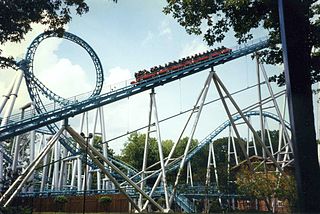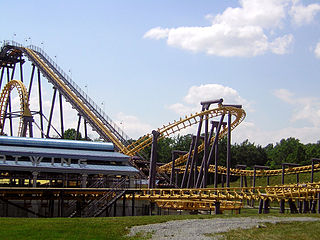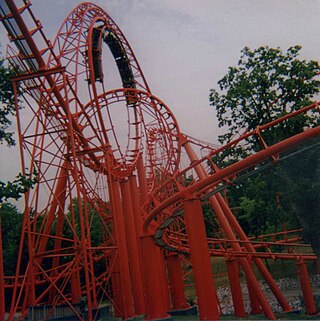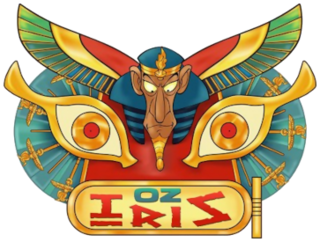
A wooden roller coaster is a type of roller coaster classified by its wooden track, which consists of running rails made of flat steel strips mounted on laminated wood. The support structure is also typically made of wood, but may also be made of steel lattice or truss, which has no bearing on a wooden coaster's classification. The type of wood often selected in the construction of wooden coasters worldwide is southern yellow pine, which grows abundantly in the southern United States, due to its density and adherence to different forms of pressure treatment.

A roller coaster inversion is a roller coaster element in which the track turns riders upside-down and then returns them to an upright position. Early forms of inversions were circular in nature and date back to 1848 on the Centrifugal railway in Paris. These vertical loops produced massive g-force that was often dangerous to riders. As a result, the element eventually became non-existent with the last rides to feature the looping inversions being dismantled during the Great Depression. In 1975, designers from Arrow Development created the corkscrew, reviving interest in the inversion during the modern age of steel roller coasters. Elements have since evolved from simple corkscrews and vertical loops to more complex inversions such as Immelmann loops and cobra rolls. The Smiler at Alton Towers holds the world record for the number of inversions on a roller coaster with 14.

The Riddler's Revenge is a steel stand-up roller coaster located at Six Flags Magic Mountain. Manufactured by Bolliger & Mabillard, the ride opened as the park's eleventh roller coaster on April 4, 1998, setting multiple world records among stand-up coasters. Originally located in the Movie District section of the park, which later became Metropolis in 2017, The Riddler's Revenge was also the park's single biggest investment at a cost of $14 million. It features a height of 156 feet (48 m), a maximum speed of 65 mph (105 km/h), six inversions, and a track length of 4,370 feet (1,330 m).

Drachen Fire was a steel roller coaster located at Busch Gardens Williamsburg in Williamsburg, Virginia. Manufactured by Arrow Dynamics, the ride opened to the public in 1992. Drachen Fire featured a 150-foot tall (46 m) lift hill, six inversions, and a zero-gravity camelback element. One of the inversions was removed after the 1994 season to improve ride comfort. The track was light blue with silver supports, and it was located in the Oktoberfest portion of the park behind Verbolten and Das Festhaus. It was originally configured with three trains, each consisting of red cars with grey seats, and featured red trim lights that illuminated the trains at night. Drachen Fire was closed in the middle of the 1998 season following a history of low ridership and complaints of roughness. It remained standing until its demolition in 2002.

Kumba is a steel roller coaster located at Busch Gardens Tampa Bay in Tampa, Florida. Manufactured by Bolliger & Mabillard, the ride opened in 1993. It stands 143 feet (44 m) tall and has a top speed of 60 miles per hour (97 km/h). Kumba features a total of seven inversions across the 3-minute ride. It is Busch Gardens Tampa Bay's oldest roller coaster that is still operating, following the closure of Scorpion in 2024.

Dominator is a floorless roller coaster located at Kings Dominion amusement park in Doswell, Virginia. Built by Bolliger & Mabillard, it originally opened in 2000 as Batman: Knight Flight at Six Flags Ohio, in Aurora, Ohio. It was given its current name when Cedar Fair purchased the Ohio park in 2004. However, following Six Flags Ohio ’s eventual permanent closure in 2007, the coaster was relocated to Kings Dominion, where it reopened on May 24, 2008. Dominator is located fairly close to the park’s main entry plaza, in the area known as International Street.

Viper is a steel roller coaster located in the Baja Ridge area of Six Flags Magic Mountain in Valencia, California. Viper is the last operating roller coaster with seven inversions to be built by American manufacturer Arrow Dynamics. The other two, Shockwave at Six Flags Great America and the Great American Scream Machine at Six Flags Great Adventure, were demolished in 2002 and 2010, respectively. The roller coaster replaced a HUSS ride type named Condor.

The Bat was a suspended roller coaster located at Kings Island amusement park in Mason, Ohio. Designed by Arrow Development, it was billed as the "first of its kind" in the world when it opened to the public on April 26, 1981. The suspended coaster concept was a radical departure from traditional roller coaster design, where guests ride below the track instead of above. Previous attempts to build coasters that hang from the track were unsuccessful and date as far back as the early 20th century. Arrow solved issues by utilizing modern technology in the design, including its tubular steel track developed in 1959 for Disneyland's Matterhorn Bobsleds.

Batwing is a steel flying roller coaster built by Vekoma at Six Flags America in Prince George's County, Maryland. This is nearly identical to defunct Nighthawk at Carowinds, however that ride has a slightly different ending, and different paint scheme. The ride is a exact clone of the also now-defunct Firehawk at Kings Island.

The Joker's Jinx is a steel roller coaster at Six Flags America in Prince George's County, Maryland. The ride utilizes linear induction motor technology to launch the train from 0 to 60 mph (97 km/h) in just over three seconds.

Orient Express was a steel roller coaster located at Worlds of Fun in Kansas City, Missouri. Introduced in 1980, the ride was manufactured by Arrow Huss and designed by Ron Toomer. It was replaced in 2004 by Spinning Dragons, a Gerstlauer spinning roller coaster. The red-orange track was located between the two entrances of the park. The station house was retained for use with a haunted attraction during the park's annual Halloween event.

Shockwave was a roller coaster manufactured by Arrow Dynamics at Six Flags Great America in Gurnee, Illinois. Standing 170 feet (52 m) tall and reaching speeds of 65 miles per hour (105 km/h), it opened in 1988 as the world's tallest and fastest looping roller coaster with a record-breaking seven inversions: three vertical loops, a boomerang, and two regular corkscrews. Shockwave was closed in 2002 and has been dismantled.

Poltergeist is a steel roller coaster located at Six Flags Fiesta Texas in San Antonio, Texas. Designed by Werner Stengel and manufactured by Premier Rides, the roller coaster opened to the public on May 28, 1999. Its track was fabricated by Dynamic Structures and Intermountain Lift, Inc.

Adventure Express is a mine train roller coaster located in the Adventure Port section at Kings Island amusement park in Mason, Ohio. Manufactured by Arrow Dynamics, the roller coaster opened to the public on April 13, 1991. A portion of the ride's design drew inspiration from the Indiana Jones franchise. Similar to other mine trains, the Adventure Express uses a lap bar restraint and does not feature any inversions.

Canobie Corkscrew was a steel sit-down roller coaster located at Canobie Lake Park amusement park in Salem, New Hampshire. Canobie Corkscrew is one of many Arrow Development Corkscrew models produced between 1975 and 1979. The coaster was removed in 2021.

Carolina Cyclone is an Arrow Dynamics roller coaster located at Carowinds in Charlotte, North Carolina. The coaster is located in the Carolina Boardwalk area of the park. Built in 1980 by now defunct coaster manufacturer Arrow Dynamics, it was the first roller coaster to have four inversions, two loops and two corkscrews.

OzIris is an inverted roller coaster designed by Bolliger & Mabillard operating at Parc Astérix in France since 7 April 2012. It is only one of two Bolliger & Mabillard inverted coasters in France, the other being The Monster at Walygator Parc. It is named after the Character Iris from the French comic Asterix.

Sky Scrapper is a flying roller coaster at World Joyland in Wujin, Changzhou, Jiangsu, China. Sky Scrapper was one of World Joyland's opening day attractions, officially opening on April 30, 2011. The 2,805.1-foot-long (855.0 m) ride stands 131.3 feet (40.0 m) tall, and features a top speed of 54.7 mph (88.0 km/h). Designed by Swiss firm Bolliger & Mabillard, Sky Scrapper restrains riders in the prone position and features five inversions.

Nitro is a steel Floorless Coaster at Imagicaa amusement park in Khopoli, Maharashtra, India. Manufactured by Bolliger & Mabillard, the roller coaster reaches a maximum height of 132 feet (40 m) and a maximum speed of 65.2 miles per hour (104.9 km/h). The coaster also features five inversions. Nitro opened to the public in October 2013.




















